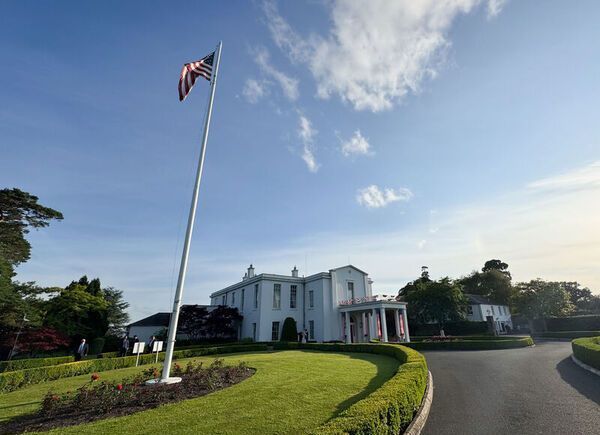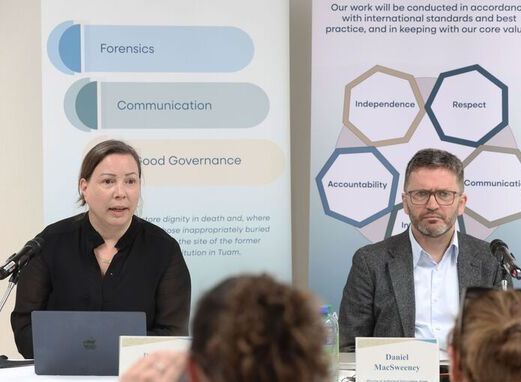New Yorker Mary Ann Flynn (1899-22) was the daughter of County Leitrim immigrants, daughter-in-law to Patrick Keane and grandmother of James Psaki.
By Peter McDermott
Jim McNiff loves a mystery.
There are no shortages of those for family researchers, but, every so often, one in particular draws him in.
Such is the case with Patrick J. Keane, who was born in Tarbet, Co. Kerry, in 1868 and died in New York in 1919.
“They’re more than a rock in a cemetery,” the Bronx-born McNiff said of those whose stories he uncovers. “This gives them a life to me.”
It helps also when he makes contact with descendants.
In this instance, Keane’s great-grandson James Psaki encouraged him to keep searching.
And so, in an early draft of his findings, McNiff writes about immigrant grandfather Constantine Psaki’s home town, Thessaloniki (aka Salonica) in Greece, where “kites will float upon the winds coming off the Thermaic Gulf on March 15. Lagana bread will be served on this day called ‘Clean Monday.’ For those observing the introduction to Lent, the bread will be served with shellfish. Ten days later, on March 25, the kites will be replaced by fireworks and parades that celebrate Greek Independence Day.”
March has significance for retired Colorado-based real-estate developer James Psaki for another reason: more than half of his heritage can be traced to Ireland. Yet, according to McNiff, when it comes to expressing pride it’s all about the achievements of his daughters
They are the Rev. Kristen, a Unitarian minister; Dr. Stephanie, Senior Advisor on Human Rights and Gender Equity, Office of Global Affairs, U.S. Department of Health and Human Services; and the first-born, Jennifer, who is the White House Press Secretary. All three have retained the family name in their personal and professional lives.
Psaki credits their success to his former wife, Connecticut psychotherapist Eileen Medvey, who grew up in a family from New York that was even more Irish than his own.
[caption id="attachment_113617" align="alignnone" width="225"]
Still, the commitment to public service was foretold by his father, the New York City-born Dr. Raoul Psaki. In 1942, he graduated with a medical degree from Georgetown University; soon the army got him and he would stay for 25 years. The year 1942 also saw his marriage to Mary Agnes Keane, whose four grandparents were from Ireland, including the above-mentioned Kerry immigrant.
Patrick, when almost 50, volunteered to play a part in the war effort in Europe in 1917. Now Mary Agnes’s new husband Raoul — whose own maternal grandmother’s parents were from Cork — would embark on his mission of duty in Europe. It would take him beyond the war; after postgraduate work at MIT, the Mayo Clinic and Walter Reed General Hospital, he served as Chief Surgeon of the United States Army, Communications Zone in Europe, and as commanding officer of the 819th Hospital Center in Orleans, France, before taking his final army position in Savannah, Ga.
Retiring at the rank of colonel, he was from 1968 the Director of Rehabilitation Medicine at Pilgrim State Hospital in Long Island, and later held the same position at the VA Hospital in Northport, N.Y.
“Throughout his life, his Catholic faith and his commitment to family were central to his values,” said an obituary published upon his death in 2009. “He believed in fostering the education of young people and he was a generous contributor to the education of his grandchildren and to universities he attended.”
Mary Agnes, the only child of Anthony Keane and the former Mary Ann Flynn, predeceased him in 1987. Mary Ann Flynn Keane, the daughter of immigrants from Leitrim, was in her early 20s when she died of tuberculosis in New York in 1922.
Eileen Medvey’s family, the Daileys, can point to service in recent times in the NYPD and in the military going back to the 19th century. Pennsylvania-born John Marshall Dailey was an officer in the 4th U.S. Cavalry during the Civil War. He married Margaret O’Hara of Brooklyn, the daughter of parents from Dublin and Kilkenny. Their son John Jr. wed Ellen Doyle, whose roots were in Wexford.
John Jr. is Eileen’s grandfather, but McNiff is curious about Col. Raymond Dailey, one of his 11 siblings and a World War I vet who would have a long life through the 1970s. He found him in a group photo with President Franklin Roosevelt, but has yet to determine what the occasion was.
However, it is Patrick J. Keane, on the Psaki side of the family, who intrigues him most. At age 51, while on furlough in early 1919, he drowned in New York. Patrick had arrived as an immigrant 30 years earlier, but would combine stints overseas with the Munster Fusiliers and family life in the city. When the U.S. joined the war in 1917, Keane responded to a request for men with experience to rejoin the British army. He enlisted in the Royal Engineers, in the division of Inland Waterways, Transportation and Docks.
“His first assignment was in France and Belgium, where he served for 15 months,” McNiff writes in his first draft.
One morning in April 1919, Keane told his wife, the former Julia Mulry, that he was headed out to the docks to look for work. He was hardly, though, in a precarious position financially, as he was due to receive almost all of his service pay. This was confirmed after his death via correspondence with the British consulate, and the money was quite readily and happily given over to Julia in Astoria, Queens.

Brooklyn-born Margaret O’Hara (1844-1931) was the wife of John Marshall Dailey of the 4th U.S. Cavalry.
McNiff doesn't easily believe the idea that an experienced soldier like Keane would’ve accidentally drowned, even as the result of misadventure; all the more so given the sort of work he did as a “sapper” with the Royal Engineers in the European war.
The family researcher has come up with another possibility: he was killed in an accident reported in the newspapers that same week. It involved the returning “Saxonia” troopship, a propellor of which struck the assisting U.S. Navy tug USS “Freehold.” The tug sank with the loss of three lives. Only one of the dead was listed on the manifest of the “Freehold”; the other two are unaccounted for and unnamed in reports.

Raymond Dailey, on the far left holding a hat, in an undated photograph with President Franklin Roosevelt. A World War I veteran, he was one of 12 children born to Margaret O’Hara Dailey.
McNiff suggests that maybe Patrick, while looking for work on the docks, asked permission to volunteer with the tug as it was helping fellow soldiers on their return journey to their families.
“I don’t think anybody knows how he died,” he said, adding that a family friend rather than Julia identified the body.
“It’s an investigation. You are finding out about people who are long gone,” he added about the appeal of his work generally.
Typically, McNiff, who lives with his wife in the Boston area near their grandchildren, might read or hear about two or three elements of a particular episode and he’ll say, “That sounds like a story I want to tell.”









